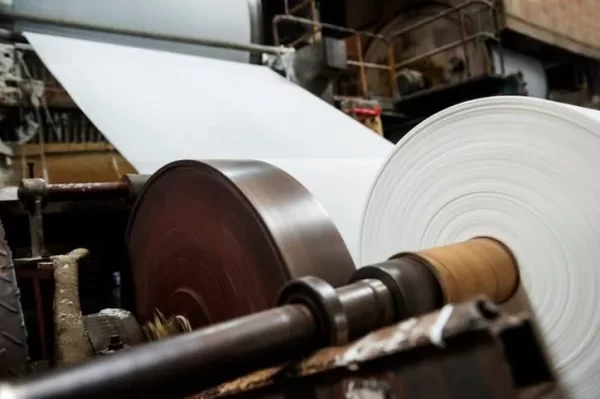
Papermaking is a manufacturing industry that uses raw materials such as wood, reeds, bagasse, rice straw, wheat straw, cotton straw, hemp straw, and cotton to make pulp and then manufactures the pulp into paper and cardboard. Papermaking is also a complex process that involves pulp beating, sizing, filling and other processes to produce paper with various properties.
Why do we need to add fillers to paper? What role does calcium carbonate, the most commonly used filler, play in papermaking?
Everyone who makes paper has some answers. For example, adding a certain amount of filler can increase the number of light scattering interfaces inside the paper, that is, there are three different interfaces between fiber and air, between filler and fiber, and between filler and air. Among these three interfaces, the filler and air The difference in refractive index is larger, thereby increasing the opacity.
Of course, adding fillers can also improve the whiteness and uniformity of the paper, improve the feel, etc. The most important thing is that after adding fillers to the paper, 5% to 30% of fiber can be saved, which has a significant effect on cost reduction.
Since the promotion of neutral sizing technology, calcium carbonate has been widely used in the papermaking industry, firstly as a papermaking filler, and secondly as a coating pigment. Calcium carbonate is rich in sources and cheap. It has fine particles and high whiteness. It can significantly improve the opacity of paper, increase the ink absorbency of paper, make the paper softer and tighter, and improve the gloss.
Calcium carbonate modification for papermaking
Although calcium carbonate is one of the important fillers in the paper industry, unmodified calcium carbonate has poor compatibility and binding force with pulp fibers, and has a low retention rate, which can easily cause material interface defects and reduce the mechanical strength of paper. Therefore, calcium carbonate needs to be modified, and the modification methods mainly include chemical coating modification and surface modification.
(1) Chemical coating modification
The surface of heavy calcium carbonate is modified in the Ca(OH)2-H2O-CO2 system. After nano-coating, the cleavage surface of the particle crystal is rough and the edges and corners are passivated, which improves its dispersion performance. At the same time, the nano-coated GCC and There is electrostatic attraction between the fibers, which causes the paper fibers to form a network structure and generate a strong force, thereby improving the tensile index, filler retention rate, bursting index, tearing index and folding endurance of the filled paper.
Using cationized chitosan and carboxymethyl cellulose as modifiers, the light calcium carbonate PCC filler is processed using the principle of polyelectrolyte compounding. Since the polyelectrolyte compound is deposited and coated on the surface of PCC, its particle size is obvious. It becomes larger, the particle distribution is concentrated, the uniformity is improved, and the specific surface area is doubled. Compared with unmodified PCC, modified PCC shows better retention performance. It relies on the joint action of mechanical entrapment and colloidal adsorption to remain on the fiber surface and in the pores between fibers in the form of single particles and flocs.
(2) Surface modification
The surface of nanometer calcium carbonate is modified with γ-methacryloyloxypropyltrimethoxysilane (KH570). The silane coupling agent KH570 is hydrolyzed to generate silicon hydroxyl (Si—OH), which interacts with the hydroxyl groups on the surface of nanometer calcium carbonate. Condensation is carried out to form Ca-O-Si bonds, thereby achieving stable and effective chemical grafting. The interlayer spacing of the modified nanometer calcium carbonate surface crystals becomes larger, the polarity is reduced, the surface energy is reduced, the lipophilicity is enhanced, and the dispersion is improved. After coating, the optical properties are improved, the surface strength of the paper is increased, and the hydrophobic properties are improved.
Sodium stearate is used to organically modify nano-CaCO3. Infrared spectrum analysis shows that sodium stearate can be successfully grafted on the surface of CaCO3 powder, reducing the surface energy of the powder, reducing agglomeration between particles, and improving the dispersion of the powder. properties and bonding properties with resin. The modified nano-CaCO3 was blended with water-based polyurethane and glycerol, and evenly coated on the surface of the paper after cooling. The results showed that the friction and mechanical properties of the coated anti-skid paper were better, and could be used to prepare anti-skid linings and anti-skid for transportation packaging tray.
Compound calcium carbonate
With the continuous advancement of papermaking technology and powder processing technology, it has become a significant trend to utilize the physical and chemical properties of different minerals to learn from each other and improve the added value and functionality of products. In papermaking, the technology of using kaolin, titanium dioxide, pyrophyllite, dolomite, illite, tremolite, talc, wollastonite, etc., mixed with calcium carbonate to make composite products is quite mature. The proportion used in the specific formula There are slight differences in types, but the principles are similar.
The papermaking industry has a large demand for calcium carbonate filler and has high market recognition. It is a relatively mature application field. In the future, calcium carbonate for papermaking can focus on developing some high-purity, functional (modified, special morphology, regular morphology) products and try to seek breakthroughs in the mid-to-high-end market.
